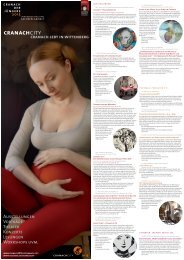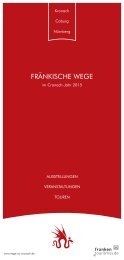In the Footsteps of Cranach - A Journey of Discovery
Twelve German towns and cities have come together in the 'Routes to Cranach' project to bring the life and works of the renowned Renaissance artist Lucas Cranach to the widest audience.
Twelve German towns and cities have come together in the 'Routes to Cranach' project to bring the life and works of the renowned Renaissance artist Lucas Cranach to the widest audience.
Create successful ePaper yourself
Turn your PDF publications into a flip-book with our unique Google optimized e-Paper software.
4<br />
Where Lucas <strong>Cranach</strong> painted Martin Lu<strong>the</strong>r<br />
Wittenberg<br />
Lucas <strong>Cranach</strong> <strong>the</strong> Elder was appointed to <strong>the</strong> Saxon<br />
court in Wittenberg by <strong>the</strong> Elector Frederick <strong>the</strong> Wise in 1505.<br />
He lived <strong>the</strong>re for almost half a century and created paintings<br />
that are now on view in major museums around <strong>the</strong> world.<br />
He painted portraits <strong>of</strong> <strong>the</strong> electors and reformers, created<br />
altarpieces and small sketches <strong>of</strong> Venus, Eve and o<strong>the</strong>r archetypal<br />
heroines. <strong>Cranach</strong> lived and worked at <strong>the</strong> Renaissance<br />
courtyards at Schlossstrasse 1 and Markt 4.<br />
However, he not only managed a successful art workshop,<br />
he also ran a print shop, took over <strong>the</strong> only pharmacy<br />
in Wittenberg and was granted <strong>the</strong> right to sell wine and beer.<br />
<strong>In</strong> 1516 he painted <strong>the</strong> Ten Commandments panel for Wittenberg<br />
council, which can now be seen in Lu<strong>the</strong>r’s House. <strong>Cranach</strong><br />
himself became a member <strong>of</strong> <strong>the</strong> council a few years later,<br />
and from 1537/38 onwards was elected mayor several times.<br />
His son Lucas <strong>Cranach</strong> <strong>the</strong> Younger assumed control<br />
<strong>of</strong> his workshop later on. <strong>In</strong> <strong>the</strong> late 1540s, fa<strong>the</strong>r and son<br />
worked toge<strong>the</strong>r on <strong>the</strong> Reformation altar in St Mary’s Church,<br />
which has been on <strong>the</strong> list <strong>of</strong> UNESCO World Heritage sites<br />
since 1996.<br />
The <strong>Cranach</strong> courtyards had survived through <strong>the</strong> ages<br />
as a remarkable testimony to <strong>the</strong>se times but presented a bleak<br />
picture in <strong>the</strong> latter years <strong>of</strong> <strong>the</strong> GDR. Thanks to <strong>the</strong> work <strong>of</strong><br />
<strong>the</strong> <strong>Cranach</strong> Foundation and restoration by <strong>the</strong> town, <strong>the</strong> state<br />
<strong>of</strong> Saxony-Anhalt and <strong>the</strong> German government, <strong>the</strong> courtyards<br />
are now a cultural focal point. <strong>In</strong> 2007, <strong>the</strong>y were recognised<br />
as a cultural monument <strong>of</strong> national importance. The courtyard<br />
at Markt 4 houses <strong>the</strong> <strong>Cranach</strong>’s World exhibition, which provides<br />
an overview <strong>of</strong> <strong>the</strong> family’s varied body <strong>of</strong> work, explores<br />
<strong>the</strong> processes in <strong>the</strong> workshop and displays treasures such as<br />
<strong>Cranach</strong>’s murals. It also hosts touring exhibitions.







